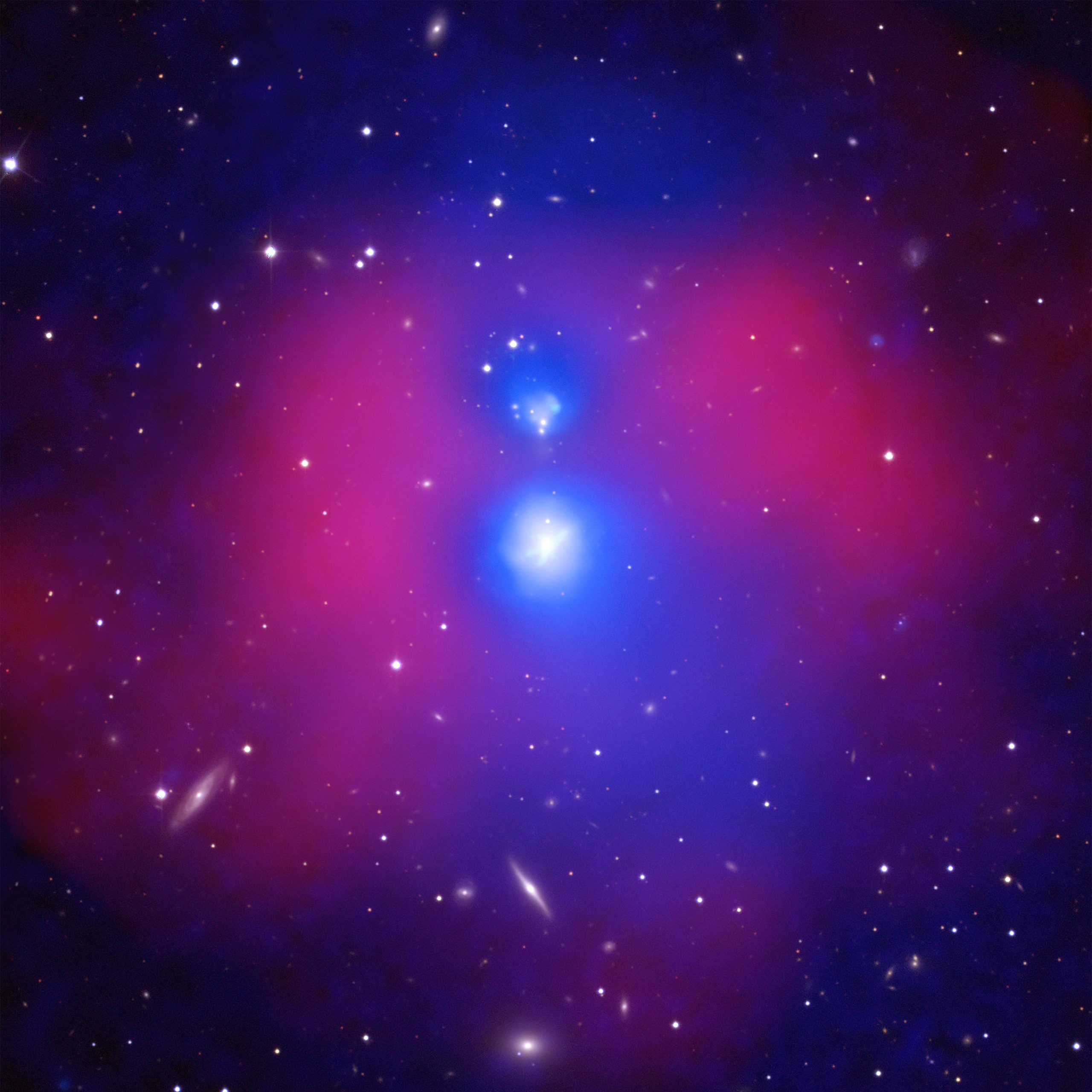星系聚集带来温暖
As the holiday season approaches, people in the northern hemisphere will gather indoors to stay warm. In keeping with the season, astronomers have studied two groups of galaxies that are rushing together and producing their own warmth.
The majority of galaxies do not exist in isolation. Rather, they are bound to other galaxies through gravity either in relatively small numbers known as “galaxy groups,” or much larger concentrations called “galaxy clusters” consisting of hundreds or thousands of galaxies. Sometimes, these collections of galaxies are drawn toward one another by gravity and eventually merge.
Using NASA’s Chandra X-ray Observatory, ESA’s XMM-Newton, the Giant Metrewave Radio Telescope (GMRT), and optical observations with the Apache Point Observatory in New Mexico, a team of astronomers has found that two galaxy groups are smashing into each other at a remarkable speed of about 4 million miles per hour. This could be the most violent collision yet seen between two galaxy groups.
The system is called NGC 6338, which is located about 380 million light-years from Earth. This composite image contains X-ray data from Chandra (displayed in red) that shows hot gas with temperatures upward of about 20 million degrees Celsius, as well as cooler gas detected with Chandra and XMM (shown in blue) that also emits X-rays. The Chandra data have been combined with optical data from the Sloan Digital Sky Survey, showing the galaxies and stars in white.
The researchers estimate that the total mass contained in NGC 6338 is about 100 trillion times the mass of the Sun. This significant heft, roughly 83% of which is in the form of dark matter, 16% is in the form of hot gas, and 1% in stars, indicates that the galaxy groups are destined to become a galaxy cluster in the future. The collision and merger will complete, and the system will continue to accumulate more galaxies through gravity.
Previous studies of NGC 6338 have provided evidence for the regions of cooler, X-ray emitting gas around the centers of the two galaxy groups (known as “cool cores”). This information has helped astronomers to reconstruct the geometry of the system, revealing that the collision between the galaxy groups happened almost along the line of sight to Earth. This finding has been confirmed with the new study.
The new Chandra and XMM-Newton data also show that the gas to the left and right of the cool cores, and in between them, appears to have been heated by shock fronts — similar to the sonic booms created by supersonic aircraft — formed by the collision of the two galaxy groups. This pattern of shock-heated gas has been predicted by computer simulations, but NGC 6338 may be the first merger of galaxy groups to clearly show it. Such heating will prevent some of the hot gas from cooling down to form new stars.
A second source of heat commonly found in groups and clusters of galaxies is energy provided by outbursts and jets of high-speed particles generated by supermassive black holes. Currently this source of heat appears to be inactive in NGC 6338 because there is no evidence for jets from supermassive black holes using radio data from the GMRT. This absence may explain the filaments of cooling gas detected in X-ray and optical data around the large galaxy in the center of the cool core in the south. The filters used in the composite image do not show the optical filaments, and the X-ray filaments are the small, finger-like structures emanating from the center of the cool core in the south, at approximately 2 o’clock, 7 o’clock and 8’o’clock.
A paper describing these results was published in the September 2019 issue of the Monthly Notices of the Royal Astronomical Society and is available online. The first author is Ewan O’Sullivan of the Center for Astrophysics | Harvard & Smithsonian (CfA) in Cambridge, Massachusetts, and the co-authors are Gerrit Schellenberger (CfA), Doug Burke (CfA), Ming Sun (University of Alabama in Huntsville, Alabama), Jan Vrtilek (CfA), Larry David (CfA) and Craig Sarazin (University of Virginia, Virginia).
NASA’s Marshall Space Flight Center in Huntsville, Alabama, manages the Chandra program for NASA’s Science Mission Directorate in Washington. The Smithsonian Astrophysical Observatory in Cambridge and Burlington, Massachusetts, controls Chandra’s science and flight operations.
Image credit: X-ray: Chandra: NASA/CXC/SAO/E. O’Sullivan; XMM: ESA/XMM/E. O’Sullivan; Optical: SDSS
Read more from NASA’s Chandra X-ray Observatory.
For more Chandra images, multimedia and related materials, visit:
http://www.nasa.gov/chandra
随着假期的临近,北半球的人们会聚集在室内取暖。为了配合这个季节,天文学家们研究了两组星系,它们正快速地聚集在一起,产生自己的热量。
大多数星系并不是孤立存在的。相反,它们通过引力与其他星系联系在一起,要么是数量相对较少的“星系群”,要么是由成百上千个星系组成的更大的“星系团”。 有时,这些星系集合在重力作用下相互吸引并最终合并。
利用NASA的钱德拉X射线天文台、欧洲航天局的XMM-牛顿卫星、巨米波射电望远镜(GMRT)以及新墨西哥州的阿帕奇波因特天文台的光学观测,一个天文学家团队发现两个星系群正以大约每小时400万英里的惊人速度相互碰撞。这可能是迄今为止两个星系群之间所见过的最激烈的碰撞。
这个星系被称为NGC 6338,距离地球约3.8亿光年。这张合成图像包含了来自钱德拉的X射线数据(以红色显示),显示温度高达2000万摄氏度的高温气体,以及用钱德拉和XMM(以蓝色显示)探测到的更冷的气体,这些气体也会发射X射线。钱德拉的数据与来自斯隆数字巡天的光学数据相结合,显示出白色的星系和恒星。
研究人员估计,NGC6338中包含的总质量大约是太阳质量的100万亿倍。这个巨大的质量,大约83%以暗物质的形式存在,16%以热气体的形式存在,还有1%以恒星的形式存在,表明这些星系群在未来注定会成为一个星系团。碰撞和合并将完成,系统将继续通过引力积累更多的星系。
新的钱德拉和XMM-牛顿卫星数据也显示,冷核左右两侧之间以及中间的气体似乎已被冲击波加热——类似于超音速飞机产生的音爆。这种被冲击波加热的气体模式已经被计算机模拟所预测,但NGC6338可能是星系群中第一次清晰显示这种模式的合并。这样的加热会阻止一些热气体冷却下来形成新的恒星。
通常在星系群和星团中发现的第二种热源是由超大质量黑洞产生的高速粒子的爆发和喷射所提供的能量。目前,这个热源在NGC 6338中似乎是不活跃的,因为没有证据表明来自超大质量黑洞的射流使用了来自GMRT的无线电数据。这种缺失可能解释了在x射线和光学数据中探测到的冷却气体的细丝,它们围绕着位于南部冷核中心的大星系。合成图像中使用的滤光片没有显示光学丝束,X射线丝束是在大约2点、7点和8点时从南部冷核中心发出的手指状小结构。
描述这些结果的论文发表在2019年9月的《皇家天文学会月刊》上,并可在线获取。 第一作者是天体物理学中心的Ewan O’Sullivan | 哈佛和史密森尼(CfA),马萨诸塞州剑桥市,合著者是Gerrit Schellenberger(CfA),Doug Burke(CfA),Ming Sun(阿拉巴马州亨茨维尔阿拉巴马大学),Jan Vrtilek(CfA),Larry David( CfA)和Craig Sarazin(弗吉尼亚弗吉尼亚大学)。
位于阿拉巴马州亨茨维尔的NASA马歇尔太空飞行中心为华盛顿的美国宇航局科学任务理事会管理钱德拉项目。位于马萨诸塞州剑桥和伯灵顿的史密森天体物理天文台控制着钱德拉的科学和飞行业务。
图片来源:X-ray: Chandra: NASA/CXC/SAO/E. O’Sullivan; XMM: ESA/XMM/E. O’Sullivan; Optical: SDSS
有关更多钱德拉图片,多媒体和相关资料,请访问:

